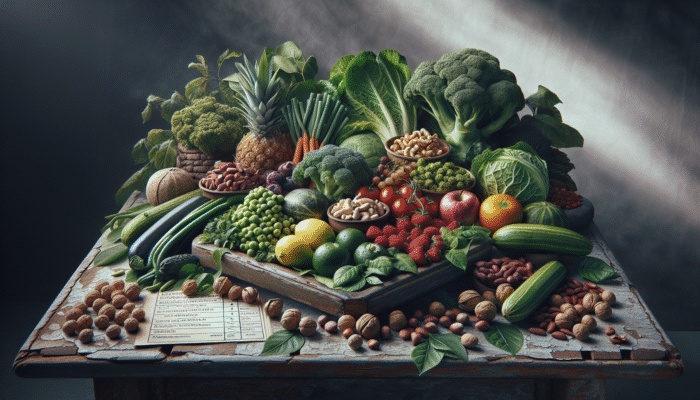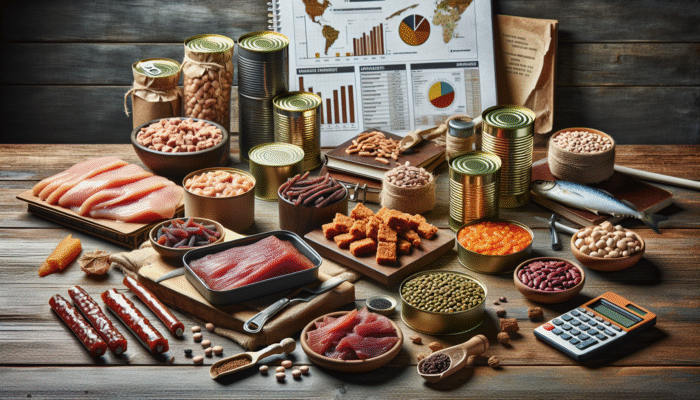Strategic Emergency Preparedness: Optimising Your Meal Planning for Survival
Effective survival meal planning necessitates careful and strategic preparation. Emergencies can arise unexpectedly, underscoring the importance of a comprehensive approach to food and water management. Such a strategy can greatly influence your resilience during critical situations. It is essential to consider various emergencies by evaluating different environments, cultural practices, and potential crises. By adopting this thorough approach, you not only arm yourself with the necessary resources but also develop the knowledge and confidence required to navigate through challenging scenarios when they arise.
Creating a Diverse Stockpile of Non-Perishable Foods for Emergencies

Non-perishable foods form the bedrock of any resilient emergency food inventory. Items like canned goods, dried beans, rice, and pasta boast long shelf lives, often enduring for years when stored correctly. When building your food stock, it is vital to prioritise items abundant in essential nutrients. This means focusing on foods that offer adequate carbohydrates, proteins, and healthy fats. For example, canned fruits and vegetables provide necessary vitamins, whereas canned fish or meat supply the protein needed for maintaining muscle health during high-stress conditions.
Furthermore, various regions worldwide have traditional foods that serve as excellent non-perishable solutions. For instance, preserved fish or fermented soy products like tempeh are staples in Asian diets, while European cultures offer delightful options such as sun-dried tomatoes and olives. By incorporating a diverse range of non-perishable items into your stockpile, you not only ensure sustenance but also keep your meals varied and enjoyable—this diversity is crucial for maintaining morale during challenging periods.
When assembling your emergency food supplies, it’s imperative to consider dietary restrictions and personal preferences. This means including gluten-free grains like quinoa or amaranth, alongside vegetarian options like lentils and chickpeas. Regularly check expiration dates and implement a rotation system to maintain the freshness of your supplies. This practice helps minimise waste and guarantees a reliable food stock.
Effective Water Storage and Purification Techniques for Emergencies
Water is an irreplaceable resource for survival, making it crucial to understand the best methods for storing and purifying it to ensure hydration during emergencies. Depending on your specific climate and surroundings, it is essential to store water in clean, food-grade containers to create an adequate supply for emergencies. Aim to store at least one gallon of water per person per day, taking into account the length of time you may need to sustain both yourself and others.
Many cultures employ traditional purification techniques like boiling or solar disinfection, both of which are highly effective. Boiling water for at least one minute eliminates most pathogens, rendering it safe for drinking. Alternatively, the solar disinfection method involves filling clear plastic bottles with water and placing them in direct sunlight for several hours—this technique is frequently used in areas with limited resources.
Chemical purification methods, such as chlorine dioxide tablets and iodine, are also preferred for their reliability and effectiveness. Each purification method has its unique advantages and disadvantages, so it is vital to understand your local water sources and potential contaminants when choosing the most appropriate purification strategy.
Additionally, incorporating a portable water filter into your emergency supplies is a wise decision. These filters efficiently eliminate bacteria and protozoa, ensuring that even questionable water sources become safe for consumption. This capability is crucial for survival in various environments worldwide.
Crafting a Detailed Emergency Meal Plan for Effective Resource Utilisation
A well-structured emergency meal plan is not merely a list of food items; it embodies a strategic method for effectively using your stocked supplies. Start by assessing the items you currently have available and categorising them into meals to guarantee a balanced intake of essential nutrients. An exemplary meal plan could feature breakfast choices like oatmeal, canned beans, and rice, with lunch and dinner comprising hearty stews created from an assortment of canned vegetables and proteins.
When devising meals, prioritise ease of preparation and minimal cooking requirements, especially when resources may be scarce. Ready-to-eat meals, canned soups, or dehydrated foods can significantly simplify meal preparation during emergencies. Furthermore, embrace versatility; many ingredients can be utilised across multiple dishes, thus reducing redundancy while enhancing flavour.
The psychological aspect of eating during crises should not be overlooked. Including comfort foods or familiar flavours can substantially uplift morale and instil a sense of normalcy. For instance, if you have favourite spices or sauces, ensure to incorporate them into your planning to enrich your dining experience.
Finally, clearly communicate your meal plan with family or group members, ensuring that everyone understands how to prepare meals and allocate resources wisely. This collaborative approach fosters a sense of community, enabling individuals to cope more effectively during difficult times.
Selecting Nutrient-Dense Foods for Optimal Health During Emergencies

Choosing nutrient-rich foods is essential for effective survival meal planning. Maintaining optimal health and energy levels during crises is crucial, and selecting the right foods can provide the necessary fuel and nourishment needed to endure challenging situations.
Incorporating High-Calorie Foods to Sustain Vital Energy Levels
In survival scenarios, high-calorie foods are indispensable for maintaining energy levels. Foods rich in fats, such as nuts, nut butters, and seeds, serve as exceptional energy sources. Just a few almonds or a spoonful of peanut butter can provide a quick energy boost during physically demanding tasks like gathering resources or constructing shelter.
Including granola bars or energy bars, particularly those fortified with vitamins and minerals, can also be advantageous. These compact energy sources are convenient to store and consume on the go, making them ideal for inclusion in emergency kits.
Moreover, dried fruits such as raisins and apricots offer a sweet energy source, packed with calories, natural sugars, and fibre. These foods are useful for maintaining stamina during extended periods when cooking may not be feasible.
Consider adding cooking oils like olive oil or coconut oil to enhance your energy-dense food supply. These oils not only improve flavour but also provide concentrated calories. Understanding the caloric content of the foods you stock can assist in tailoring your emergency meals for optimal energy support.
Identifying Essential Vitamins and Minerals for Health Maintenance
While high-calorie foods are crucial, vitamins and minerals are equally important for sustaining overall health during emergencies. Consuming a diverse range of foods can help prevent deficiencies that may arise from a limited diet. Canned vegetables, such as spinach or carrots, provide essential vitamins, while fruit options deliver vital antioxidants.
Certain food items can also supply a blend of nutrients and flavour. For instance, freeze-dried vegetables retain most of their nutritional value and can be easily included in soups, stews, or side dishes, making them a smart addition to any survival meal plan.
Fortified foods, such as cereals or milk alternatives, can further enhance nutrient intake. These options provide essential nutrients like vitamin D and calcium, which are critical for maintaining bone health during challenging times.
Lastly, consider incorporating herbal supplements or multivitamins into your emergency stockpile. These can serve as a practical means to ensure your body receives the necessary nutrients, particularly when fresh produce is scarce. Balancing nutrient-dense foods with high-calorie options is vital for sustaining overall health in survival situations.
Incorporating Protein Sources to Support Muscle Health

Protein is essential for muscle maintenance and recovery, particularly during the physical exertion that often accompanies emergencies. Canned meats, such as chicken or tuna, are excellent protein sources that can be easily incorporated into various meals. Alternatively, dried beans and lentils offer nutritious, shelf-stable, plant-based protein options.
Jerky can also be a fantastic addition for those looking for variety in their protein-rich snacks. Available in various types—from beef to turkey to plant-based alternatives—jerky caters to diverse dietary preferences while ensuring adequate protein intake.
When preparing meals, aim for a balanced distribution of protein sources throughout the day. For instance, breakfast could include eggs (if available), lunch might feature a bean salad, and dinner could consist of a protein-rich stew with canned meat. This balanced approach supports muscle health and ensures that meals remain interesting and enjoyable.
Additionally, understanding how to pair your protein sources with other food groups can enhance their nutritional value. For example, combining beans with rice creates a complete protein, ensuring you receive all essential amino acids necessary for recovery and overall health.
Prioritising Hydration and Electrolyte Balance
Hydration is a critical yet often overlooked component of survival meal planning; it is vital for maintaining bodily functions. Beyond water, consider incorporating beverages such as coconut water or electrolyte-infused drinks to replenish lost minerals during physical exertion. Adequate hydration directly impacts energy levels and cognitive function, which can be crucial during survival situations.
Electrolytes like sodium, potassium, and magnesium are essential for muscle function and overall health, particularly during strenuous activities. Foods like bananas, spinach, and nuts are excellent sources of these electrolytes and are easy to store.
Developing a hydration strategy for emergencies is equally important. Ensure you have a plan for collecting and purifying water, alongside a supply of hydration products that can help maintain your electrolyte balance. During high activity periods, consume snacks containing both water and electrolytes, such as fruits or vegetables, to effectively support your hydration strategy.
Incorporating hydration into your survival meal plan helps prevent dehydration, contributing to sustained energy levels and overall well-being. Proper hydration empowers you to think clearly and make informed decisions during crises, significantly enhancing your chances of survival.
Mastering Alternative Cooking Techniques for Crisis Situations
Adjusting to alternative cooking methods is essential for effective survival meal planning when modern conveniences are unavailable. Understanding various cooking techniques can prepare you for situations where traditional cooking appliances are inaccessible, ensuring you can still create nourishing meals.
Exploring Alternative Cooking Methods for Survival
Surviving without modern amenities requires ingenuity, particularly in cooking. Open fire cooking is one of the oldest methods, achievable through techniques like grilling, boiling, or roasting. Building a secure fire pit allows you to prepare meals while providing warmth and light.
When cooking over an open flame, consider elevating pots above the fire using stones or a grate. This method promotes even cooking and helps prevent burning. Additionally, cooking in cast iron pots can enhance flavours and ensure reliable heat retention, making them an excellent choice for outdoor cooking.
Moreover, solar cookers can be a valuable investment for long-term survival strategies. These cookers harness sunlight to bake, boil, or steam food without requiring fuel, offering an eco-friendly cooking alternative. They are particularly beneficial in sunny regions, enabling you to prepare meals without depleting resources.
When cooking without amenities, improvisation is crucial. Rocks, sticks, or metal scraps can serve as substitutes for conventional cookware. For example, a hollowed-out log can be used as a container for boiling water, while stones can effectively retain heat for cooking.
Implementing Safe Food Handling Practices in Survival Situations
Cooking in unconventional environments necessitates strict food handling practices to prevent contamination. Prioritise cleanliness by ensuring that hands, surfaces, and utensils are hygienic before preparing food. Use natural materials like leaves or clean stones as makeshift utensils to minimise contact with unclean surfaces.
It is crucial to understand the importance of cooking food to safe temperatures when preparing meals in survival situations. While canned foods typically do not require additional cooking, ensure that fresh or wild ingredients are thoroughly cooked to eliminate harmful bacteria, thus protecting your health.
When using a communal cooking area, be vigilant about cross-contamination. Avoid using the same tools or surfaces for raw and cooked foods, as this can lead to foodborne illnesses. Adopting these best practices ensures that your meals are safe and nutritious, significantly improving your chances of maintaining health during emergencies.
Improvising Kitchen Tools for Effective Survival Cooking
In the absence of modern kitchen tools, learning to improvise can be invaluable. For instance, a sharp rock or a sturdy stick can serve as a knife for cutting food. Large leaves can act as makeshift plates, while smaller leaves can be shaped into cups or bowls.
In emergencies, creativity is crucial in overcoming challenges. A stick with a pointed end can serve as a makeshift skewer for grilling meat over an open flame. If you have access to a container, you can create a simple pot by burying it in the ground, allowing for slow cooking while retaining heat underground.
Your surroundings can also provide resources for improvised tools. Twigs can be fashioned into tongs, while large stones can function as weights for pressing food or holding pots over flames. Adapting your environment to meet your cooking needs can significantly enhance your survival experience, allowing you to continue enjoying nourishing meals during crises.
Promoting Sustainable Food Sourcing Practices for Resilience
Incorporating sustainable food sourcing into your survival meal planning is a strategic approach that is essential for long-term sustainability. Mastering the skills to gather, grow, and hunt for food can greatly enhance your resilience during emergencies, ensuring that you are not solely reliant on pre-packaged supplies.
Foraging for Edible Plants: An Essential Survival Skill
Foraging can be immensely beneficial, providing a free source of nutrients while fostering a connection to your local environment. Many regions are abundant in wild edibles, including dandelion greens, wild garlic, and various berries. Safely identifying these plants is crucial to avoid toxic varieties that could jeopardise your health.
Researching local edible plants in your area is the first step in your foraging journey. Books and online resources can assist you in recognising plants that are safe for consumption. Consider attending local foraging workshops for hands-on experience and insights from knowledgeable guides.
Practising ethical harvesting methods is essential when foraging. Take only what you need and leave enough for the plants to propagate, ensuring that future generations can access these resources while promoting biodiversity and fostering a sustainable relationship with the environment.
Additionally, familiarising yourself with the growing seasons of various plants can optimise your foraging efforts. Certain wild edibles bloom at specific times of the year, allowing you to plan your food sourcing around their seasonal availability effectively.
Understanding the Basics of Fishing and Hunting for Emergency Food Supply
Fishing and hunting can effectively supplement your emergency food supply with fresh protein. Basic fishing skills, such as casting a line or setting traps, can yield substantial rewards if you have access to water sources. In many cultures, fishing is a traditional practice; understanding local fish species can enhance your skills and techniques.
Alongside fishing, gaining insights into local wildlife can provide hunting opportunities. Familiarise yourself with regulations and ethical practices in your area to ensure that you engage in sustainable and legal hunting. Techniques such as tracking, trapping, and using natural bait can offer various methods for securing food.
When fishing or hunting, prioritise safety; use appropriate tools and equipment, and ensure you have the necessary permits and understanding of local wildlife. Including these practices in your survival meal plan can greatly enhance your ability to sustain yourself during emergencies while connecting you with local traditions and practices.
Maximising Gardening Opportunities in Limited Spaces for Sustainable Food
Gardening can be an excellent means of achieving sustainable food sourcing, even in limited spaces. Embracing container gardening is a popular method for those with minimal outdoor space, allowing you to cultivate herbs, vegetables, and fruits in pots or small raised beds.
Start by selecting plants that thrive in your climate and possess quick growth cycles, such as radishes, lettuce, or herbs. This approach not only provides food but also nurtures a sense of accomplishment and connection to nature during challenging times.
Utilising vertical gardening techniques can further maximise your space, allowing you to grow plants upwards instead of outwards. This method is particularly advantageous in urban settings where space is at a premium. Hanging planters, wall-mounted pots, or trellises can enable you to cultivate a variety of plants without requiring extensive ground space.
Incorporating permaculture principles can also enhance your gardening success. This holistic approach focuses on creating self-sufficient ecosystems, ensuring that your garden remains productive while minimising reliance on external inputs. Establishing a garden can provide a dependable food source during emergencies while fostering a sense of purpose and community as you share your knowledge and harvest with others.
Strategic Meal Planning for Long-Term Survival Scenarios
Efficient meal planning is vital for navigating long-term survival scenarios, ensuring you remain nourished and healthy. Understanding how to rotate food stocks, adapt to seasonal changes, and engage in community support can significantly enhance your survival strategy, enabling you to thrive despite various challenges.
Implementing a Food Stock Rotation System for Freshness
Regularly rotating your food supplies is essential for preventing spoilage and ensuring freshness. Employing the “first in, first out” method guarantees that you consume older items before newer stock, minimising waste while maximising the longevity of your pantry.
Create a system for tracking expiration dates by labelling items with their purchase or use-by dates and organising them accordingly. This will help you maintain your supplies and simplify meal planning by ensuring you know which items must be consumed first.
Moreover, involving family or group members in the stock rotation process can be beneficial. Educating others about food storage methods and the importance of rotation fosters shared responsibility and ensures collective preparedness in emergencies.
In addition to physical rotation, consider adjusting meal plans based on the items you have available. This flexibility will allow you to fully utilise your food supply and avoid redundancy, keeping your meals varied and enjoyable even in survival scenarios.
Adjusting Meal Plans to Reflect Seasonal Variations for Nutritional Value
Seasonal changes can significantly affect food availability, and adapting your meal plans can help ensure a steady supply of essential nutrients. Understanding which foods are in season in your area allows you to build meal plans around fresh ingredients, thereby enhancing flavour and nutritional value.
During the spring and summer months, consider incorporating fresh herbs, vegetables, and fruits into your meals. In contrast, focus on hearty root vegetables and grains during the autumn and winter months. This seasonal approach not only supports better meal planning but also strengthens your connection to local agriculture and sustainability.
Additionally, preserving seasonal foods through canning, drying, or freezing can extend their availability into the colder months. This practice reduces waste and ensures access to nutrient-rich foods year-round, bolstering your survival strategy.
Engaging with local farmers' markets or community-supported agriculture initiatives can also provide access to seasonal produce. Building relationships with local growers fosters a sense of community and enhances your understanding of sustainable food sourcing.
Creating Community Through Food Sharing Initiatives for Enhanced Resilience
Community food sharing initiatives can strengthen survival strategies while fostering connections among individuals. By participating in local food co-ops, community gardens, or food distribution networks, you can support your community while also receiving assistance during challenging times.
Organising food-sharing events can facilitate the exchange of surplus items, creating a collaborative environment focused on sustainability and resourcefulness. This approach reduces waste while building resilience among community members, ensuring that everyone has access to essential food supplies.
Engaging in community initiatives also opens up opportunities for learning. Workshops on food preservation, foraging, and cooking techniques can broaden your knowledge and skills while cultivating a support network for future emergencies.
Establishing a culture of sharing nurtures connections among individuals and families, enhancing overall community resilience. Solidarity during difficult times can amplify your chances of survival while fostering relationships that endure beyond emergencies.
Fostering Mental and Emotional Resilience During Crises
Surviving challenging situations requires not only physical preparedness but also mental and emotional resilience. Integrating strategies to bolster mental well-being during emergencies can significantly enhance your overall survival experience, ensuring you cope effectively with stress and uncertainty.
Incorporating Comfort Foods to Boost Morale in Tough Times
During stressful periods, comfort foods can play a pivotal role in uplifting morale and providing a sense of stability. Including familiar and nostalgic meals in your survival meal planning can enhance emotional well-being, creating stability amidst chaos and uncertainty.
Reflect on your comfort foods—be it a cherished family dish or a beloved snack. These readily available items can deliver a psychological lift, making difficult moments more manageable and less daunting.
Additionally, experimenting with new recipes can help sustain interest in your meals. Infusing flavours and spices from various cultures can transform mundane meals into enjoyable experiences, alleviating stress and promoting a positive atmosphere.
Sharing meals with others can further enhance emotional well-being. Eating together fosters a sense of community, allowing individuals to connect, share stories, and support each other during challenging times.
Remember that food serves more than just sustenance; it can also be a source of comfort and connection. By prioritising comfort foods in your meal planning, you create a more supportive environment during emergencies, promoting overall emotional resilience.
Establishing a Consistent Routine for Enhanced Stability During Emergencies
Creating a regular meal schedule can provide structure and stability during chaotic circumstances. Consistent routines help individuals feel more secure and in control, alleviating anxiety and uncertainty in adverse situations.
Consider developing a meal calendar that outlines when and what to eat each day. This will simplify meal preparation and ensure balanced nutrition, making it easier to plan and allocate resources effectively.
Involve everyone in the planning process, encouraging group members to share their preferences and contribute meal ideas. This collaborative approach fosters community, enhancing accountability and commitment to the routine.
While routines are essential, it’s equally important to remain flexible. Life during emergencies can be unpredictable, so be prepared to adjust your meal schedule as necessary. Maintaining the ability to adapt while following a consistent framework can help bolster mental resilience.
Ultimately, a structured routine offers comfort, allowing individuals to navigate challenges more confidently and clearly.
Developing Coping Strategies for Food Scarcity and Anxiety
Confronting limited food resources can induce significant stress and anxiety, making it vital to cultivate effective coping strategies. Acknowledging the psychological impact of food scarcity empowers individuals to manage their emotions constructively.
Begin by fostering a positive mindset. Focus on what you have rather than what you lack, and practice gratitude for the resources available to you. This shift in perspective can help mitigate feelings of deprivation and cultivate resilience even in the face of scarcity.
Consider developing a plan for extending your food supplies. Incorporating filler foods like rice, pasta, or legumes can stretch meals, allowing you to maintain nourishment while minimising waste. Utilising every part of your food can also contribute to resourcefulness during difficult times.
Engaging in mindfulness practices, such as meditation or deep breathing exercises, can effectively manage stress related to food scarcity. Taking the time to pause and reflect can ground individuals, fostering a sense of calm amidst chaos and uncertainty.
Ultimately, nurturing a resilient mindset during food shortages can enhance your overall survival experience, promoting emotional well-being while navigating the challenges of limited resources.
Practising Mindfulness for Greater Resilience in Crisis Situations
Integrating mindfulness into your daily routine can significantly bolster emotional resilience during survival situations. Mindful eating encourages individuals to savour their food, fostering a deeper connection to the nourishment they consume and promoting gratitude for what is available.
Start by focusing on your senses while eating. Observe your food's colours, textures, and flavours, allowing yourself to appreciate each bite fully. This practice can transform a hurried meal into a rewarding experience, fostering gratitude for the resources at hand.
Additionally, incorporating mindfulness techniques such as meditation or breathing exercises can help alleviate stress and cultivate a sense of calm. Dedicating a few moments daily to mindfulness can ground individuals, promoting clarity and focus during challenging times.
Sharing mindfulness practices with others can also foster community and support. Gathering in a circle to meditate or share meals mindfully can strengthen connections and enhance emotional well-being, making the survival experience more bearable and enriching.
Ultimately, cultivating mindfulness empowers individuals to navigate challenges more easily, enhancing mental resilience and emotional stability during crises.
Frequently Asked Questions Regarding Survival Meal Planning
What does effective survival meal planning involve?
Survival meal planning entails preparing and organising meals in anticipation of emergencies or disasters, ensuring access to sufficient food supplies that are both nutritious and easy to prepare.
What are the best strategies for stocking non-perishable foods?
To effectively stock non-perishable foods, focus on items with extended shelf lives, such as canned goods, dried grains, and legumes. Regularly rotate your stock and store items in a cool, dry environment.
What are the most effective hydration strategies during emergencies?
Consider storing bottled water and learning purification methods such as boiling or using chemical tablets. Additionally, be aware of natural water sources and how to purify water from these sources.
How can I ensure adequate protein in my emergency meals?
Incorporate canned meats, beans, lentils, nuts, and seeds into your meal plan. These sources provide essential protein to support muscle function during emergencies.
What should I do if traditional cooking methods are unavailable?
Explore alternative cooking techniques such as open fire cooking, solar cookers, or improvising kitchen tools from available materials. Flexibility is key in survival situations.
What are some tips for safe foraging?
Learn to identify local edible plants, understand their growing seasons, and research which plants are safe to consume. Always forage ethically by taking only what you need.
How can I maintain my mental well-being during emergencies?
Incorporate comfort foods into your meal planning, maintain a consistent routine, and practice mindfulness. Engaging in community support can also enhance morale and emotional stability.
What role does the community play in survival meal planning?
Community initiatives enhance resilience through food sharing efforts, collective knowledge sharing, and support systems that assist individuals in navigating challenges together.
How can I adapt my meal plan to seasonal changes?
Understand which foods are in season in your area and plan meals accordingly. Preserve seasonal foods to extend their availability throughout the year.
What should I include in my emergency meal plan?
Your emergency meal plan should encompass a variety of non-perishable foods, protein sources, hydration methods, and comfort foods. Regularly rotate your supplies to ensure freshness.
Join us on our journey on X!
The post Survival Meal Planning: Essential Strategies appeared first on Survival Bite.
The Article Survival Meal Planning Strategies You Need to Know Was Found On https://limitsofstrategy.com
The Article Survival Meal Planning: Essential Strategies to Master found first on https://electroquench.com

